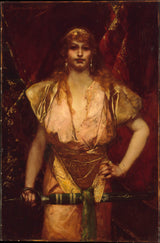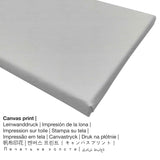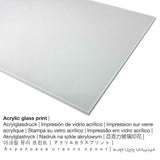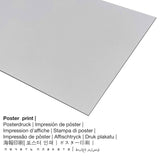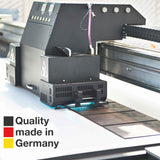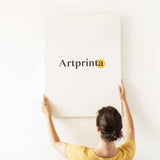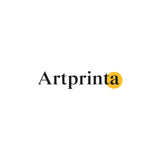Benjamin-Constant, 1886 - Eserese nke Judith - ọmarịcha nka
Ụtụ gụnyere. Mbupu gbakọrọ na ndenye ọpụpụ.
Nkọwa edemede
Nke a kariri 130 years old work of art was created by the artist Benjamin-Constant n’afọ 1886. Ihe gafere 130 year-old original was painted with the size - 47 1/2 x 31 1/2 in (120,7 x 80 cm) and was crafted with the Usoro mmanụ na kwaaji. Ibe nka bụ akụkụ nke mkpokọta nka Museumlọ ihe ngosi nka nke Obodo. With courtesy of - The Metropolitan Museum of Art, New York, Gift of J. E. Gombos, 1959 (license: public domain). : Gift of J. E. Gombos, 1959. In addition to this, the alignment of the digital reproduction is in Eserese usoro nwere akụkụ nke 2: 3, nke pụtara na ogologo bụ 33% mkpụmkpụ karịa obosara.
Nweta nhọrọ akụrụngwa ebipụta nka mara mma
In the dropdown menu next to the product offering you can select the material and sizeaccording to your preferences. Choose among the following product options now to match your preferences in size and material:
- Akwụkwọ mmado ebipụtara (akwa akwa akwa): The Artprinta poster print is a UV printed flat canvas paper with a slightly roughened texture on the surface. The print poster is particularly suited for putting the art print with the help of a custom-made frame. Please bear in mind, that depending on the absolute size of the poster we add a white margin 2-6cm around the print motif, which facilitates the framing with your custom frame.
- Mbipụta iko acrylic na-egbuke egbuke (nke nwere ezigbo mkpuchi iko): An acrylic glass print, which is sometimes denoted as a an art print on plexiglass, will change the original into brilliant décor. Moreover, the acrylic glass art print forms a good alternative to canvas and aluminidum dibond fine art replicas. Our acrylic glass protects your chosen fine art print against light and heat for between 4 and 6 decades.
- Mbipụta nke aluminom: An Aluminium Dibond print is a print material with a true depth effect. For your Aluminium Dibond option, we print the selected work of art onto the surface of the aluminum material.
- Kwaaji: A canvas print, which should not be mistaken with a real artwork painted on a canvas, is a digital image printed onto cotton canvas. A canvas creates a charming, pleasing look. The great advantage of canvas prints is that they are relatively low in weight, which implies that it is quite simple to hang up your Canvas print without the help of additional wall-mounts. A canvas print is suited for all kinds of walls.
Nkwupụta iwu: We try our utmost in order to describe our products as precisely as it is possible and to illustrate them visually on the different product detail pages. At the same time, the colors of the print materials, as well as the printing can vary somehwat from the presentation on your device's screen. Depending on your screen settings and the nature of the surface, color pigments can unfortunately not be printed 100% realistically. Since all our art reproductions are processed and printed by hand, there may also be minor variations in the motif's exact position and the size.
Banyere ngwaahịa a
| Bipụta ụdị ngwaahịa: | nka nka |
| Usoro mmeghari: | dijitalụ mmeputakwa |
| Usoro mmepụta: | mbipụta dijitalụ (Mbipụta UV ozugbo) |
| Mmalite ngwaahịa: | German mmepụta |
| Stockdị ngwaahịa: | a na-achọ |
| Ihe eji eme atụmatụ: | ime ụlọ, foto mgbidi |
| Ndozi onyonyo a: | usoro eserese |
| Oke akụkụ onyonyo: | (ogologo: obosara) 2: 3 |
| Nkọwa nke oke ihe onyonyo a: | ogologo bụ 33% mkpụmkpụ karịa obosara |
| Nhọrọ dị: | ígwè ebipụta (aluminium dibond), acrylic glass print (nwere ezigbo mkpuchi iko), mbipụta akwa akwa, mbipụta akwụkwọ mmado (akwụkwọ kwaaji) |
| Nhọrọ nke Canvas Mbipụta (akwa akwa na etiti ihe ndọtị): | 20x30cm - 8x12", 40x60cm - 16x24", 60x90cm - 24x35", 80x120cm - 31x47", 100x150cm - 39x59" |
| Mbipụta iko acrylic (nwere ezigbo mkpuchi iko) dị iche iche: | 20x30cm - 8x12", 40x60cm - 16x24", 60x90cm - 24x35", 80x120cm - 31x47" |
| Mpempe akwụkwọ mmado (akwụkwọ kwaaji) nha dị iche iche: | 40x60cm - 16x24", 60x90cm - 24x35", 80x120cm - 31x47" |
| Nhọrọ nha nha nke Dibond (ihe alumnium): | 20x30cm - 8x12", 40x60cm - 16x24", 60x90cm - 24x35", 80x120cm - 31x47" |
| Nhazi mbipụta nka: | agunyeghi |
Nkọwa ahaziri nke ihe osise
| Aha nka: | "Portrait of Judith" |
| Nhazi nke ọrụ nka: | sere |
| Nhazi nka: | nkà nke oge a |
| Century: | 19th narị afọ |
| Emepụtara n'afọ: | 1886 |
| Ogologo afọ nka nka: | 130 afọ |
| Agba na: | mmanụ na kwaaji |
| Nha izizi: | 47 1/2 x 31 1/2 na (120,7 x 80 cm) |
| Ụlọ ihe ngosi nka: | Museumlọ ihe ngosi nka nke Obodo |
| Ebe ngosi nka: | New York City, New York, Njikota Obodo Amerika |
| website: | Museumlọ ihe ngosi nka nke Obodo |
| Akwụkwọ ikike nka: | ngalaba ọha |
| Site n'aka: | The Metropolitan Museum of Art, New York, Gift of J. E. Gombos, 1959 |
| kreditline ọrụ nka: | Gift of J. E. Gombos, 1959 |
Ozi ndabere gbasara onye na-ese ihe
| Ihe nkiri: | Benjamin-Constant |
| okike onye nka: | nwoke |
| Ọrụ: | onye na-ese ihe |
| Nkewa onye nka: | omenkà nke oge a |
| Afọ ọnwụ: | 57 afọ |
| Afọ ọmụmụ: | 1845 |
| Nwuru: | 1902 |
© nwebiisinka, www.artprinta.com (Artprinta)
(© Nwebiisinka - nke Ụlọ ihe ngosi nka nke Obodo ukwu - Museumlọ ihe ngosi nka nke Obodo)
Judith, the Old Testament heroine who saved her besieged city by beheading the general Holofernes, appears as an avenging beauty, proudly bearing her sword. Painted in glinting red and gold tones, this exotic figure attests to Benjamin-Constant’s esteem for the palette and subject matter of the great early-nineteenth-century artist Delacroix. Following in the older artist’s footsteps, Benjamin-Constant traveled to Spain and Morocco in the early 1870s, a voyage that yielded inspiration, and props, for many of his pictures. He returned repeatedly to the dramatic motif of Judith, including another version shown at the Salon of 1886.

